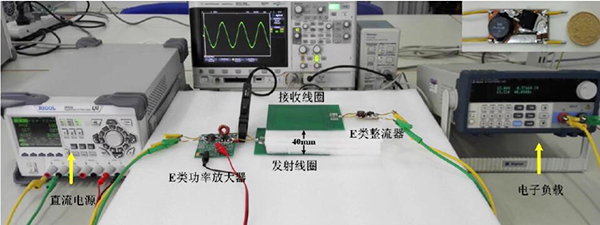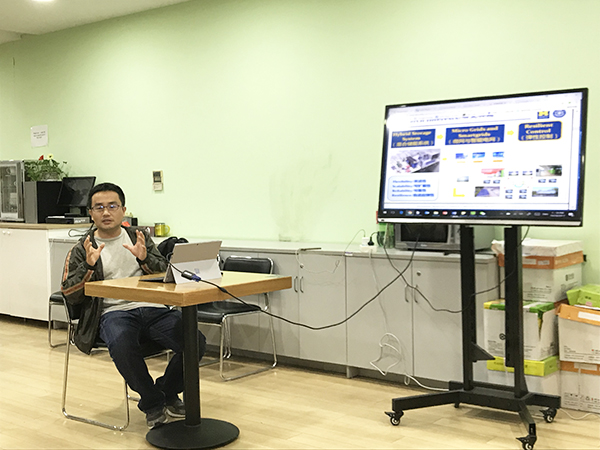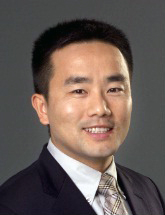The University of Michigan-Shanghai Jiao Tong University Joint Institute (UM-SJTU JI) stands at the forefront of technological innovation with its unique academic atmosphere and advanced scientific explore. JI boasts a strong research team which keeps innovating and strives to produce results that will lead the industry and ultimately benefit the human beings.
In order to help the public discover the mystery of scientific research, JI has launched a series of mini-workshop to introduce its faculty’s research.
 The experiment platform of 6.78MHz high-performance wireless power transmission
The experiment platform of 6.78MHz high-performance wireless power transmission
The well-known Maxwell equations set forth theoretically that electromagnetic waves, as a carrier of energy, can propagate through space. This theory led to the revolutionary development of wireless communication. Based on a similar physical principle, much larger electrical energy than communication signals can also be transmitted wirelessly. In recent years, due to the demand for wireless charging of various electronic devices (smartphones, tablets, wearable devices, etc.), much attention has been paid to the research of wireless power transmission. The wireless transmission of electric energy in space can be realized through many kinds of technologies, such as inductive coupling, magnetic resonance coupling, microwave and laser radiation. The magnetic resonance coupling occurs when the transmitting and receiving coils have the same natural frequency. Therefore, the magnetic resonance coupling is also referred to as resonant inductive coupling. In general, increasing the operating frequency of magnetic resonance coupling facilitates mid-range wireless power transmission systems that are lighter, more compact, and have more freedom in space. Therefore, it is generally accepted that a system operating on the megahertz (MHz) frequency band (eg, 6.78 or 13.56 MHz) based on the principle of magnetic resonance coupling is suitable for wireless power transmission of medium and small power, especially for various mobile electronic devices.

At a recent mini-workshop, Professor Chengbin Ma presented the research work on high-frequency MHz radio energy transmission in interdisciplinary areas such as integrated electronic power, radio frequency microwave, system optimization and control by his Dynamic System Control Lab since 2009. The experimental platform of 6.78MHz wireless power transmission system designed and constructed by his team achieves an efficiency of 84% from DC to DC end system after being optimized by analytical modeling and system parameter optimization, which is among the highest efficiency of the currently known MHz systems. In the past three years, his laboratory has published 16 academic papers in the fields of MHz wireless power transmission circuits, system-level new topology, analytical modeling, optimization analysis and design in mainstream IEEE Journals such as “IEEE Trans. Power Electronics.” His team has become an international leader in MHz high-frequency wireless power transmission. Chengbin Ma also briefly presented some of his ideas and cutting-edge exploration in the hybrid energy system, micro / smart grid energy management and optimization.
 Chengbin Ma is an associate professor at the UM-SJTU Joint Institute. He obtained a Ph.D. in Electrical Engineering from the University of Tokyo in September 2004. He joined the Joint Institute in August 2008 and has been teaching courses of Signals and Systems, Automatic Control, Mechtraonic Systems Design, and Major Design Experience, etc. His research interests include energy management, megahertz wireless power transfer, dynamics and motion control, and wide applications in electronic devices, electric vehicles, microgrids and smart grids, etc (web: http://umji.sjtu.edu.cn/lab/dsc/).
Chengbin Ma is an associate professor at the UM-SJTU Joint Institute. He obtained a Ph.D. in Electrical Engineering from the University of Tokyo in September 2004. He joined the Joint Institute in August 2008 and has been teaching courses of Signals and Systems, Automatic Control, Mechtraonic Systems Design, and Major Design Experience, etc. His research interests include energy management, megahertz wireless power transfer, dynamics and motion control, and wide applications in electronic devices, electric vehicles, microgrids and smart grids, etc (web: http://umji.sjtu.edu.cn/lab/dsc/).
